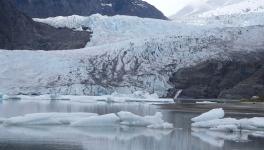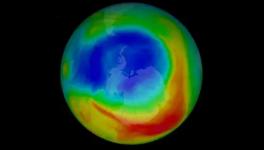Climate Change A Major Factor in the Decline of Indus Valley Civilisation 4000 Years Ago

More than 4000 years ago, the Indus Valley Civilisation thrived, spanning from Indus River Valley of modern-day Pakistan to northwestern India. Characterised by sophisticated cities with mod cons such as advanced sewage system, blooming local economy and intercultural trade, people of this Harappan culture, by around 1800 BCE moved from the cities to the smaller villages in and around the Himalayan foothills.
A recent study published in Climate of the Past has revealed that climate change was the key player in this migration, leading to the eventual decline of the ancient civilisation. The study conducted in the Woods Hole Oceanographic Institution (WHOI) found evidence that climate change drove the Harappans away from the cities leading them to the villages, a stage which is known as the Late Harappan Phase.
First, the summer monsoon rains became sparse in the floodplains of Harappa that forced the people to migrate from the cities towards villages near the Himalayas where rains were plenty to feed the population. But eventually, rains near the Himalayas also dried up that probably contributed to the ultimate demise of the Harappans.
Also Read: What the DNA of a 4500 year-old Skeleton from Rakhigarhi has to say about Ancient India
However, around 2500 BCE, a shift in weather patterns and temperatures over the Indus valley caused summer monsoons to gradually decline. With the changes in the climate, agriculture near the Harappan cities became difficult or impossible —according to Liviu Giosan, the lead author of the paper.
“Although fickle summer monsoons made agriculture difficult along the Indus, up in the foothills, moisture and rain would come more regularly. As winter storms from the Mediterranean hit the Himalayas, they created rain on the Pakistan side, and fed little streams there. Compared to the floods from monsoons that the Harappans were used to seeing in the Indus, it would have been relatively little water, but at least it would have been reliable”—explains Giosan in the study.
Evidence
However, to locate the evidence that could relate the changing pattern of seasonal rainfall and the switching of Harappans from the floodplains of Indus valley to near the Himalayas in soil samples had proved to be a difficult task. To resolve the issue, Giosan’s team took sediments from the ocean floor off Pakistan’s coast. They collected samples from several sites in the Arabian Sea. Following the collection of the core samples, the team examined the single-celled shells called foraminifera, the plankton which they found in the sediments. The planktons helped them understand which ones survived in summer and which ones in winter.
Their next step was to focus on paleo-DNA, the ancient genetic material hidden in the sediments. “The seafloor near the mouth of the Indus is a very low oxygen environment, so whatever grows and dies in the water is very well preserved in the sediment. You can basically get fragments of DNA of nearly anything that lived there” —Giosan comments regarding the ancient DNA samples collected from the sediments.
The paleo-DNA based evidence confirmed that winter monsoons were stronger and summer monsoons weaker towards late Indus valley civilisation—which corresponds to the migration from cities to villages.
The rains in the Himalayan foothills were sufficient to feed the population over a millennium, but even that dried up leading to the ultimate demise of the culture.
Reason For The Climate Change
The changes in the climatic conditions that the Harappans faced were not like what we are witnessing today i.e. man-made global warming. That period was going through a transition—a new ice age was settling in—Giosan notes. This climatic phenomenon forced colder air down from the arctic into the Atlantic and northern Europe. This, in turn, caused storms down the Mediterranean causing winter monsoons over the Indus valley and apparent dry summers.
Indus valley civilisation, as Giosan says, may have other factors for its decline—“We can’t say that they disappeared entirely due to climate- at the same time the Indo-Aryan culture was arriving in the region with Iron Age tools and horses and carts. But it’s likely that the winter monsoon played a role.”
Climate Change and Future Migration
Climate change has forced many other migrations, and it can have a more powerful impact in the future. Giosan concludes with a warning for the future—“It’s remarkable and there’s a powerful lesson for today. If you look at Syria and Africa, the migration out of these areas has some roots in climate change. This is just the beginning—sea levels rising due to climate change can lead to huge migrations from low lying regions like Bangladesh, or from hurricane-prone regions in the southern US. Back then, the Harappans could cope with change by moving, but today, you’ll run into all sorts of borders. Political and social convulsions can then follow.”
Get the latest reports & analysis with people's perspective on Protests, movements & deep analytical videos, discussions of the current affairs in your Telegram app. Subscribe to NewsClick's Telegram channel & get Real-Time updates on stories, as they get published on our website.
























